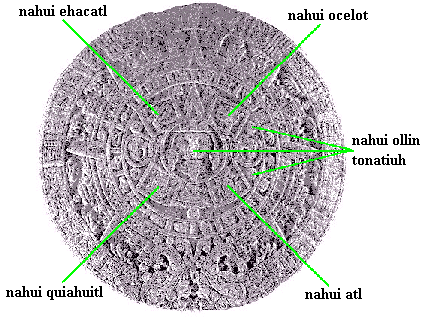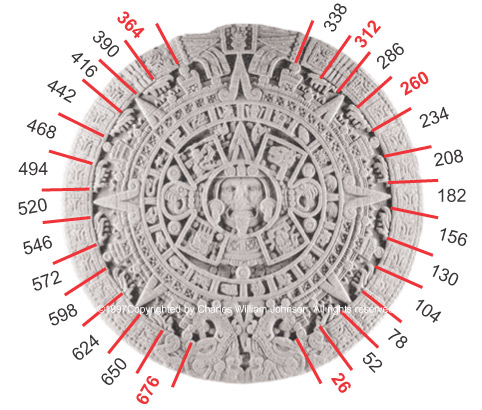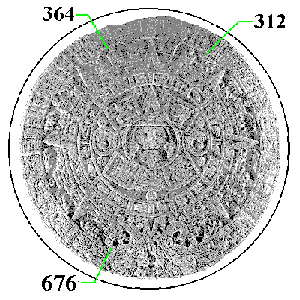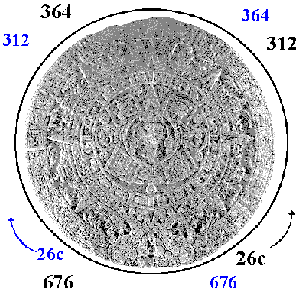SCIENCE IN ANCIENT ARTWORK
The Legend of the Four
Suns:
Math, Geometry, and Design
By
Charles William Johnson
The elements of the ancient legend of the Four Suns are sculpted upon the image of the Aztec Calendar. These four epochs were the period before the Fifth Sun, which the Aztecs were said to be living at the time the Sun Stone was sculpted in 13-acatl, supposedly the year 1479 after Christ. The Spaniards arrived at the Aztec Empire some 40 years later and buried the stonework. Knowledge was lost; the meaning(s) of the Aztec Calendar vanished like the society upon which it was constructed. Yet, the survivors of that clash of cultures trickled down information about the past. One of those popular legends, which exists in distinct versions of names and dates, concerns the four epochs:
The Aztec Calendar: the Four Suns

In a previous analysis (Cfr., Earth/matriX Essay No.15), we illustrated distinct mathematical relationships suggested by the number of years corresponding to each one of the four suns: 676, 364, 312, 676, which total 2028 years according to this particular version of the legend. Other versions in distinct codices offer different numbers of years, as in a Codex of the Vatican: 4008, 4010, 4081, 5042 (5026), a total of 17141 (17125) years.
More recently, we have been examining the manner in which the numbers of the ancient reckoning system coincide with the geometry of some of the designs of ancient artwork, especially with that of the Aztec Calendar. We find that the mathematical series of historically significant numbers enmesh fully with the spatial divisions within the Aztec Calendar. And, not only that, but we also find that the elements of design, such as the segments of the serpents, the placement of particular concentric circles, the smoking celts of the foreheads of the serpents, the paws of the serpents, the claws of the eagles, and so on, all coincide with the mathematics and the geometry in such a way that clearly suggests the presence of a conscious design. The mathematical choice of numbers, the geometry of the allotment of space, and the design elements themselves indicate an interrelationship that imply consciously assigned meanings to the sun stone.
The conscious nature of the design becomes more evident as we consider the placement of the number of years corresponding to the Four Epochs upon the face of the Aztec Calendar. The numbers corresponding to the years of each epoch appear to share a common thread based upon the 260c day-count calendar, which involves the expression 13 months times 20 days (13 x 20). The 26c series appears thusly: 26, 52, 78, 104, 130, 156, 182, 208, 234, 260, and further, 286, 312, 338, 364, 390, 416, 442, 468, 494, 520, 546, 572, 598, 624, 650, and 676. Based upon the doubling/halving computation of number series, we thus observe the numbers of the Four Suns appear on the 26c fractal series. Let us view these numbers on the Aztec Calendar:
The Numbers of
the Legend of the Four Suns
on the Aztec Calendar

The beginning and ending of the cycles reflect the elements of the design regarding the paws of the serpents on the outer ring, and the pathways or channels of their tails. In previous essays (Cfr., Earth/matriX Essay Nos. 88, 95), we have explained how this particular procedure in the design may be visualized as of the 4-movement (nahui ollin) of the central figure of the Aztec Calendar in relation to the 13-acatl glyph and the Four Suns. For now, we may observe the immediate relationship of the mathematical series 676c, and the placement on the segments of the serpents. The numbers regarding the time periods of the Four Suns do not only share a common mathematical thread through the 26c, but they now appear to reflect a relationship in the geometry and the design of the Aztec Calendar itself. In fact, if we view the specific numbers of the legend of the Four Suns and the design elements of the Aztec Calendar in a manner that reflects the visible bidirectional aspect of the outer ring of serpents, the relationship becomes even more outstanding.
The Numbers of
the Four Suns and the Design Elements
of the Aztec Calendar:
 |
 |
The procedure by which we have been relating the mathematics of the ancient reckoning system (certain historically significant numbers), with respect to the general rules of geometry and the elements of design within ancient artwork, yields convincing evidence that the basis within ancient artwork may have been more reasoned than generally considered. To observe a coincidence of so many distinct factors (such as the 260-fractal count, the numbers of years of the legend of the Four Suns, the geometrical division of space within the Aztec Calendar, and the elements of the design within that calendar), suggests just such a relationship between science and artwork.
Scholars know that the ancients computed the orbital timing of some of the planets in our solar system. The historically significant numbers exist, sculpted in stone for all to see. Yet, we are not certain as to how the computations of the timing were effected. The method of computation remains unknown. We have been exploring the possibility of peeling back that method as of the apparent logic of numbers coming out of the historical record. As observed in this extract, the apparently random numbers in the legend of the Four Suns (676, 364, 312, 676) may not have been randomly chosen at all.
The elements of the ratchet-like design on the concentric rings of the Aztec Calendar reflect an exactness and preciseness of placement and execution in the sculpture that suggest profound meanings. It may be impossible to peel back the rings, as one would the layers of an onion, and discover the core meaning of this intriguing work of art. Yet, by relating the historically significant numbers that appear in the records of ancient societies, with the concepts of geometry and, the visible elements of the ancient designs, we may find relationships that suggest the kind of logical illustrations and explanations discussed in this extract. Our perception and interpretation of the relationships may not reflect exactly and precisely those conceived by the creator of the stone sculpture itself. But, we may begin to suspect that a similar procedure served as the basis for relating math, geometry and artistic expression in the ancient artwork.
Reproduction prohibited without written consent of the author.
Your comments and suggestions are greatly appreciated:
e-mail: johnson@earthmatrix.com
Science in Ancient Artwork
The Legend of the Four Suns: Math, Geometry, and Design
Extract Nº.24
30 October 1997
©1997-2012 Copyrighted by Charles William Johnson. All Rights Reserved
Earth/matriX,
Reproduction prohibited without written consent of the author.
The Aztec Calendar: Math and Desig
THE AZTEC CALENDAR: In the book The Aztec Calendar: Math and Design, Charles William
Johnson examines the possible relationships between mathematics and geometry.
The historically significant numbers may reflect progressions which in
turn may be translated into geometrical figures and designs. No one knows
for certain how the Aztec Calendar may have been read or interpreted.
Its simbolic design is striking and has intrigued scholars for centuries.
The Aztec Calendar: Math and Design explores the stone's elements and
rings in relation to their spatial divisions in an attempt to discern
a possible method of computation, using the historically significant numbers
of the ancient reckoning system. The book promotes the existence of specific
mathematical posits that the geometrical spatial division of the calendar's
elements appear to obey.
Purchase in Amazon. |
 ISBN 1-58616-182-2  |
| Home | Books | Author |